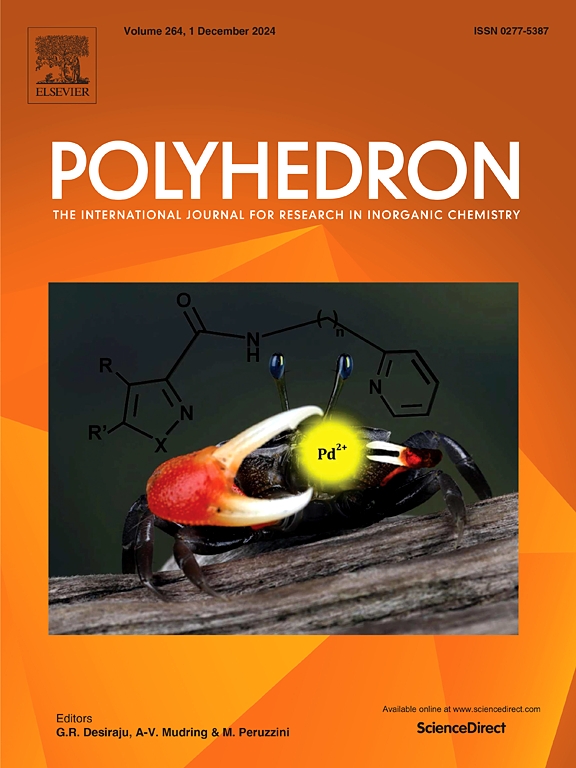Synthesis, structural characterisation, luminescence properties and DFT calculations of a new 2D polymeric network of cadmium (II)
IF 2.4
3区 化学
Q2 CHEMISTRY, INORGANIC & NUCLEAR
引用次数: 0
Abstract
The first cadmium coordination polymer (Cd–CP) of dapsone [Cd(DDS)2(NO3)2(H2O)]n was successfully synthesised by reacting Cd(NO3)2-4H2O with 4,4′-diaminodiphenylsulfone (DDS) using two different synthesis methods, slow evaporation and mechanochemical synthesis. The structure of Cd–CP was characterised by single crystal X-ray diffraction, infrared spectroscopy (IR), thermogravimetric and EDAX analysis. Cd–CP exhibits a diperiodic layered structure with interlayer hydrogen bonding and π---π interactions. In this work, the luminescence properties of 4,4′-diaminodiphenylsulphone and cadmium (II) coordination polymer are investigated in both solution and solid state. The results showed that in the solid state, the compound emits strong red light due to the ligand-to-ligand charge transfer (LLCT) mechanism (from the HOMO of the sulphur atoms to the LUMO + 1 of the DDS), which was probed by molecular orbital (MO) calculations. The ligand-to-metal charge transfer (LMCT) is due to the involvement of 5s orbital of CdII.

新型二维镉(II)聚合物网络的合成、结构表征、发光特性及DFT计算
以Cd(NO3)2- 4h2o与4,4′-二氨基二苯基砜(DDS)为原料,采用缓慢蒸发和机械化学两种不同的合成方法,成功合成了首个氨苯砜[Cd(DDS)2(NO3)2(H2O)]n的镉配位聚合物(Cd - cp)。通过单晶x射线衍射、红外光谱、热重和EDAX分析对Cd-CP的结构进行了表征。Cd-CP呈双周期层状结构,具有层间氢键和π—π相互作用。本文研究了4,4′-二氨基二苯基砜与镉(II)配位聚合物在溶液和固态下的发光特性。结果表明,通过分子轨道(MO)计算,该化合物在固体状态下由于配体到配体的电荷转移(LLCT)机制(从硫原子的HOMO到DDS的LUMO + 1)而发出强红光。CdII的5s轨道参与了配体到金属的电荷转移(LMCT)。
本文章由计算机程序翻译,如有差异,请以英文原文为准。
求助全文
约1分钟内获得全文
求助全文
来源期刊

Polyhedron
化学-晶体学
CiteScore
4.90
自引率
7.70%
发文量
515
审稿时长
2 months
期刊介绍:
Polyhedron publishes original, fundamental, experimental and theoretical work of the highest quality in all the major areas of inorganic chemistry. This includes synthetic chemistry, coordination chemistry, organometallic chemistry, bioinorganic chemistry, and solid-state and materials chemistry.
Papers should be significant pieces of work, and all new compounds must be appropriately characterized. The inclusion of single-crystal X-ray structural data is strongly encouraged, but papers reporting only the X-ray structure determination of a single compound will usually not be considered. Papers on solid-state or materials chemistry will be expected to have a significant molecular chemistry component (such as the synthesis and characterization of the molecular precursors and/or a systematic study of the use of different precursors or reaction conditions) or demonstrate a cutting-edge application (for example inorganic materials for energy applications). Papers dealing only with stability constants are not considered.
 求助内容:
求助内容: 应助结果提醒方式:
应助结果提醒方式:


